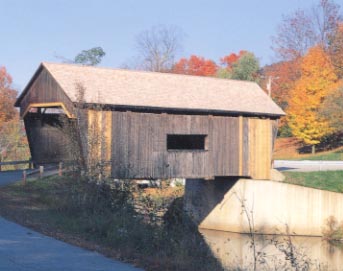
Warren's Lincoln Gap Covered Bridge - 1880
from Spanning Time: Tour 9 - Route 100 in Central Vermont¹

The Lincoln Gap Bridge crosses the Mad River just east of Route 100 at Warren Village, about one mile north of west-bound Lincoln Gap Road. The sixty-two foot structure, ten feet of it gable-end overhang, is one of two queenpost bridges in Vermont in which the truss interior and exterior are completely enclosed. The other is the School House Bridge in Lyndon.
Walter Bagley built the Lincoln Gap bridge in 1880. Bagley's claim to fame may be the peculiar construction of the bridge he left us. The roadway was strengthened with timber cross-braces and stringers and the roof was re- shingled in the fall of 1995 by Paul Ide and Jan Lewandoski.
The bridge is located within the village Historic Residential District. The village stands in the folds of a jumble of short, steep hillocks, displaying a mix of old New England and Victorian architecture. The old mill dam stands a ruin downstream from the bridge.
The Town of Warren was chartered to John Throop and Associates on November 9, 1780. With the Mad River running through the center of the town, Warren developed as a mill town. The town hosted a hoe handle factory, a clothes pin factory, a dowel, chair stock and rolling pin mill, and the Warren Wooden Bowl factory. Walter Bagley, the builder of the Lincoln Gap Bridge manufactured clapboards in South Hollow for several years.

Photo by Joe Nelson
October, 1995
1. Spanning Time Vermont's Covered Bridges by Joseph C. Nelson ©1997
